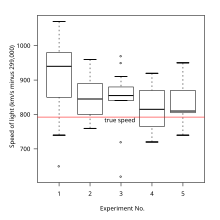|
Summary statistics In descriptive statistics, summary statistics are used to summarize a set of observations, in order to communicate the largest amount of information as simply as possible. Statisticians commonly try to describe the observations in
A common collection of order statistics used as summary statistics are the five-number summary, sometimes extended to a seven-number summary, and the associated box plot. Entries in an analysis of variance table can also be regarded as summary statistics.[1]: 378 ExamplesLocationCommon measures of location, or central tendency, are the arithmetic mean, median, mode, and interquartile mean.[2][3] SpreadCommon measures of statistical dispersion are the standard deviation, variance, range, interquartile range, absolute deviation, mean absolute difference and the distance standard deviation. Measures that assess spread in comparison to the typical size of data values include the coefficient of variation. The Gini coefficient was originally developed to measure income inequality and is equivalent to one of the L-moments. A simple summary of a dataset is sometimes given by quoting particular order statistics as approximations to selected percentiles of a distribution. ShapeCommon measures of the shape of a distribution are skewness or kurtosis, while alternatives can be based on L-moments. A different measure is the distance skewness, for which a value of zero implies central symmetry. DependenceThe common measure of dependence between paired random variables is the Pearson product-moment correlation coefficient, while a common alternative summary statistic is Spearman's rank correlation coefficient. A value of zero for the distance correlation implies independence. Human perception of summary statisticsHumans efficiently use summary statistics to quickly perceive the gist of auditory and visual information.[4][5][6] See also
References
External links
|